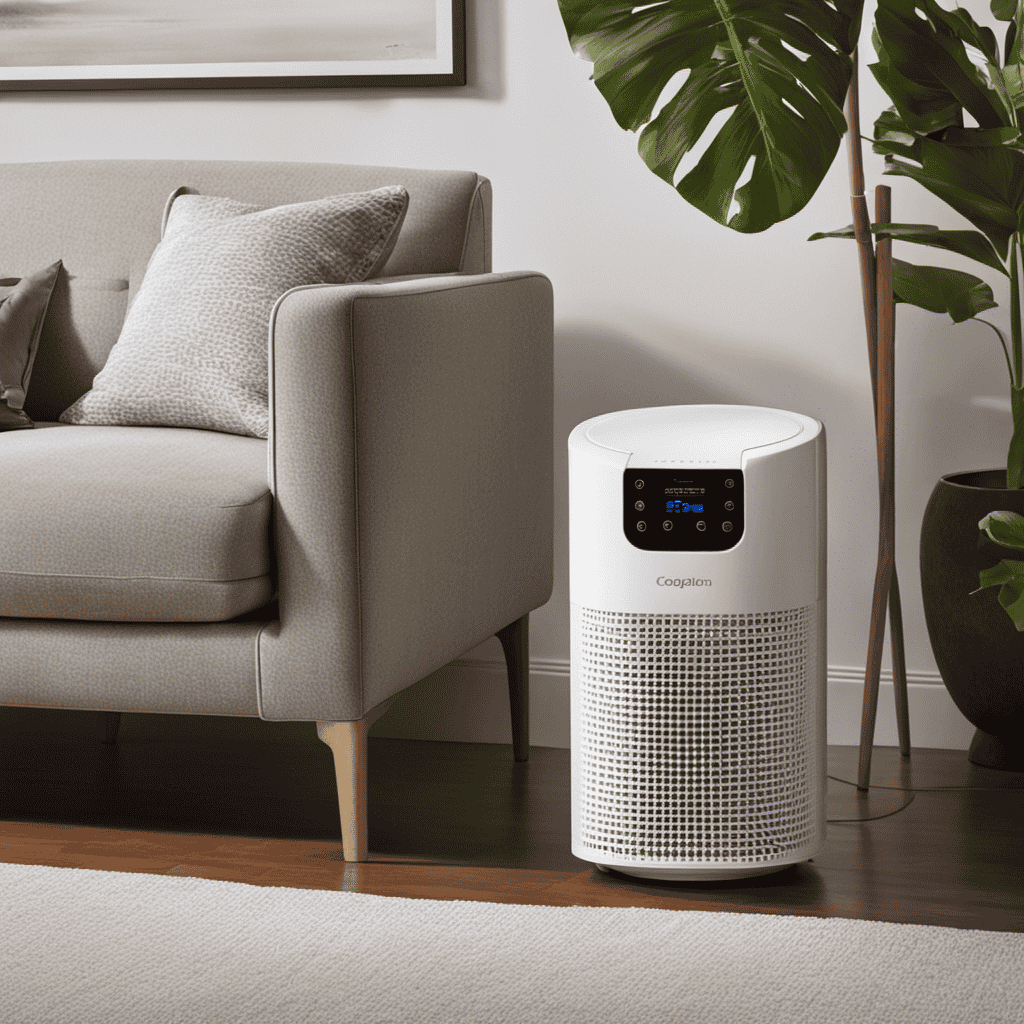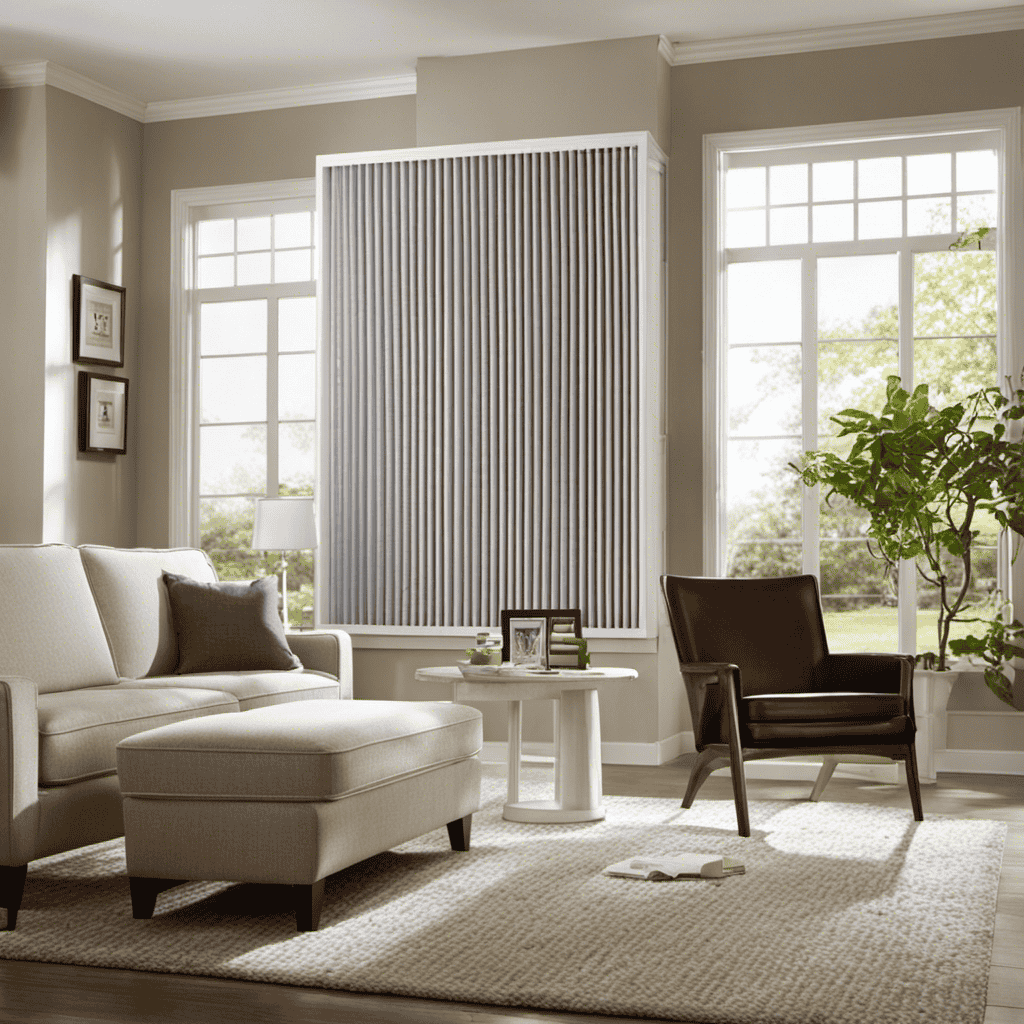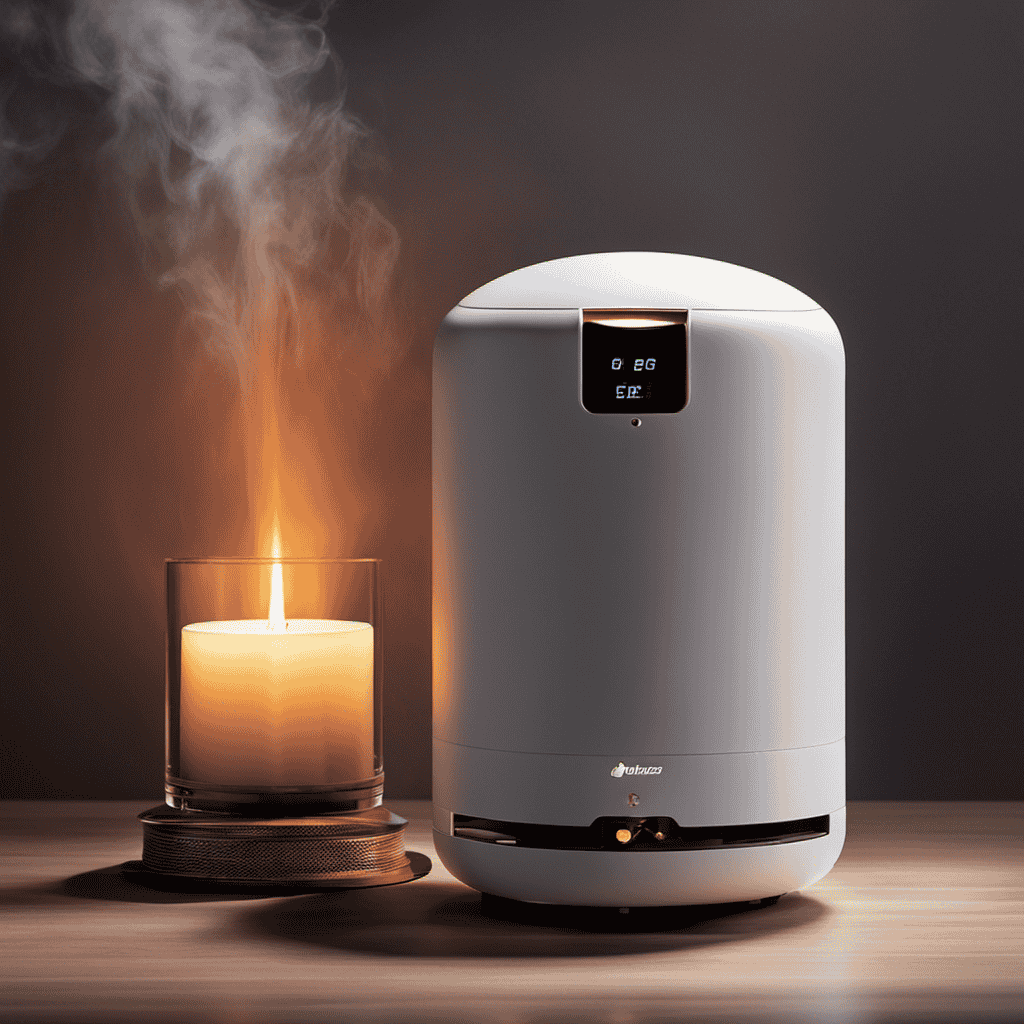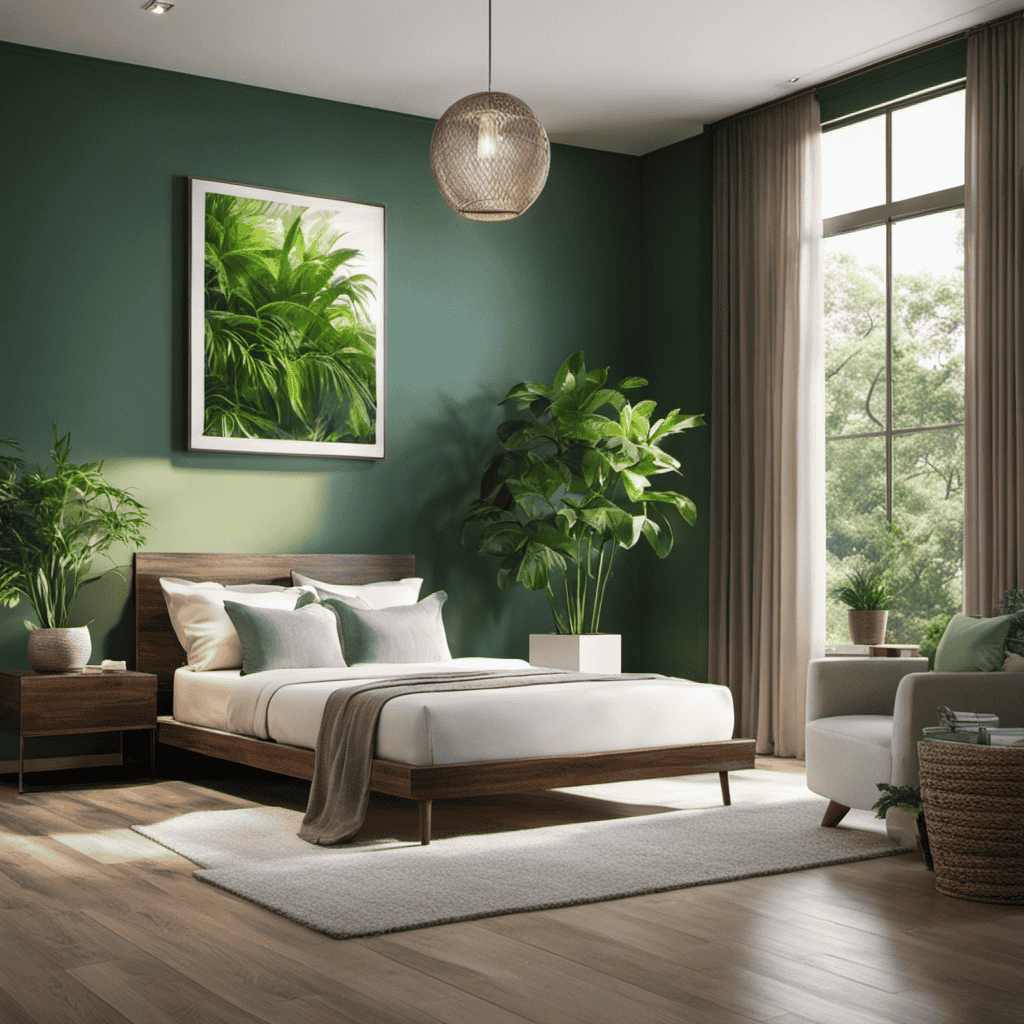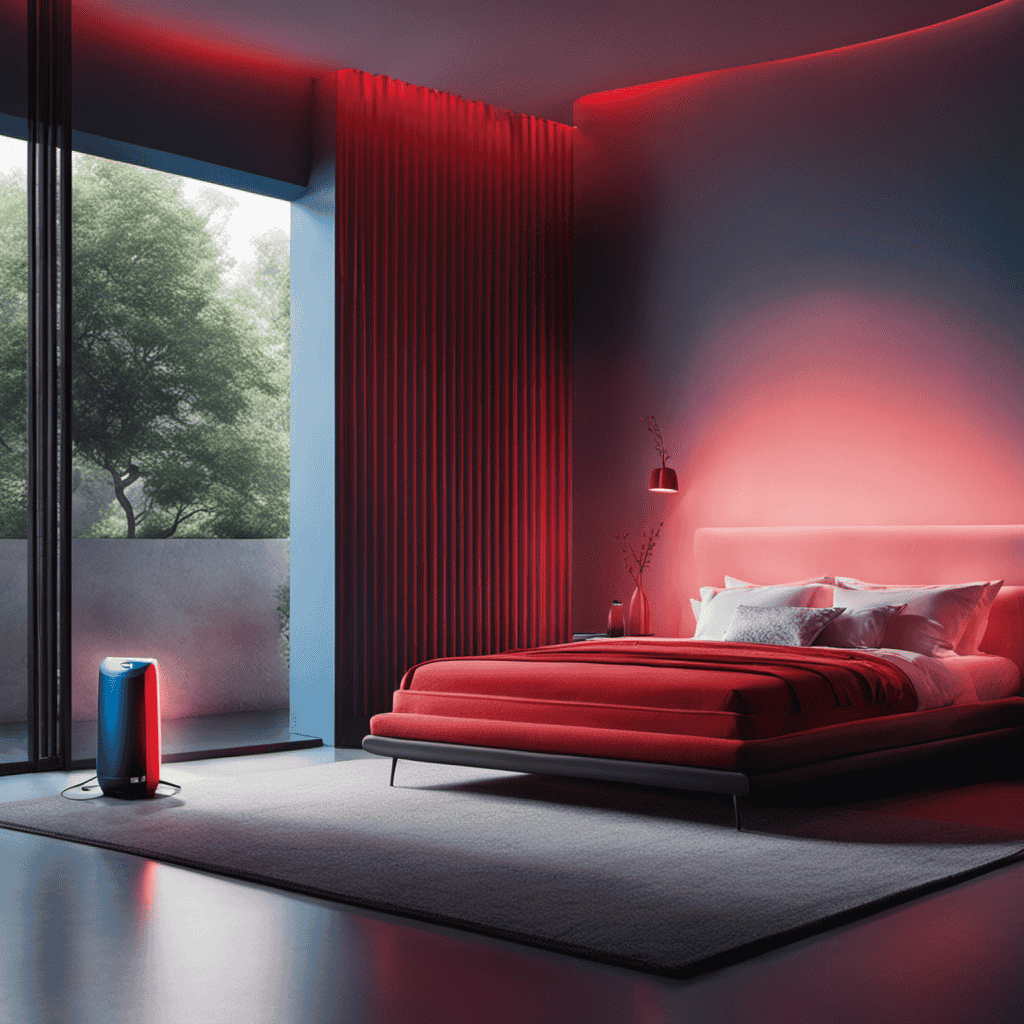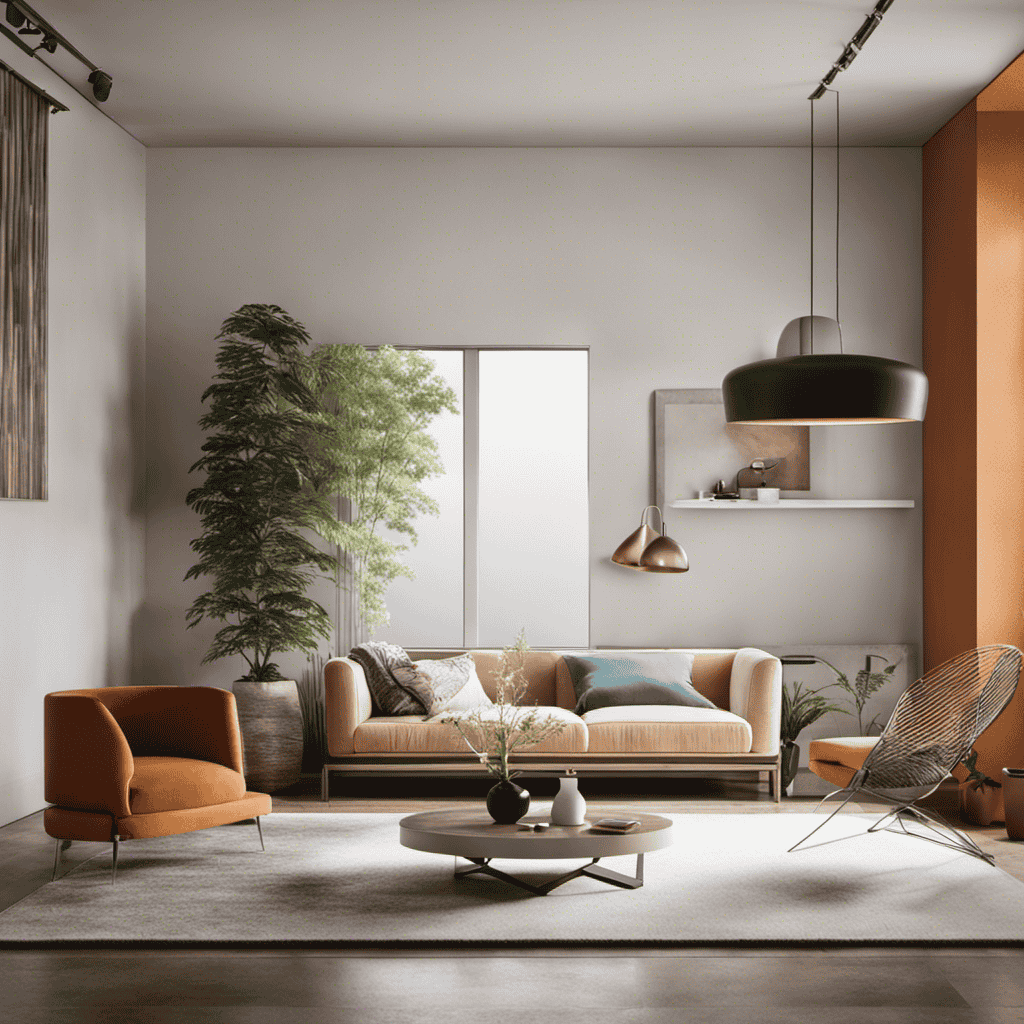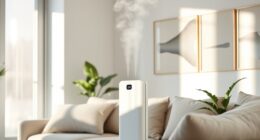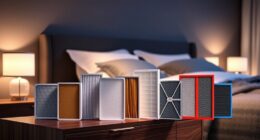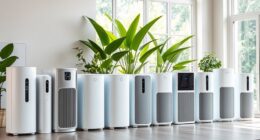As an individual who has experienced challenges with allergies and dry air, prioritizing the search for the most effective solution to enhance indoor air quality has been crucial.
Exploring the difference between an air purifier and a humidifier is like comparing apples and oranges – each serves a unique purpose in creating a healthier environment.
In this article, I will delve into the functionality, technology, and impact on indoor air quality of these two devices.
By understanding their differences, we can make an informed decision on which one best suits our needs.
Key Takeaways
- Air purifiers filter out harmful particles, while humidifiers add moisture to the air.
- Air purifiers remove pollutants like dust, pollen, and smoke particles, improving indoor air quality, while humidifiers do not purify the air or remove particles.
- Air purifiers reduce allergies and asthma symptoms, while humidifiers relieve dryness and promote respiratory health.
- Regular maintenance and care, such as cleaning and replacing filters, cleaning the water tank, and monitoring humidity levels, are important for both air purifiers and humidifiers.
Functionality
An air purifier filters out harmful particles from the air, while a humidifier adds moisture to the dry air in your home. These two devices are often used to improve indoor air quality, but they serve different purposes and employ different methods.
Air purifiers utilize various air purification methods to remove contaminants from the air. These methods include filtration, such as high-efficiency particulate air (HEPA) filters, which can capture particles as small as 0.3 microns. Other purification methods include activated carbon filters, which help eliminate odors and chemical pollutants, as well as ultraviolet germicidal irradiation (UVGI), which kills bacteria and viruses by exposing them to ultraviolet light.
On the other hand, humidifiers focus on the humidification process. They add moisture to the air, increasing the humidity level to a comfortable range. This can be especially beneficial during dry seasons or in arid climates when the air lacks moisture. Humidifiers typically work by evaporating water through various mechanisms, such as ultrasonic humidification or evaporative humidification.
Purpose
The purpose of a humidifier and an air purifier is to improve air quality and moisture levels in a room. Both devices have different functions that contribute to achieving this goal. Here are the benefits they provide:
-
Humidifier: A humidifier adds moisture to the air, increasing the humidity levels in dry environments. This is particularly beneficial during winter months when the air tends to be drier. It helps to alleviate dry skin, dry throat, and respiratory symptoms such as coughing and congestion. Additionally, it can prevent the cracking of wooden furniture and reduce the static electricity in the room.
-
Air Purifier: An air purifier removes contaminants from the air, such as dust, pollen, pet dander, and smoke particles. It filters out these pollutants and releases clean air back into the room. This is especially useful for people with allergies or asthma, as it reduces the triggers that can worsen their symptoms. It also helps to eliminate odors and improve overall indoor air quality.
Air Purification Methods
One effective method for purifying the air is by using a HEPA filter. HEPA stands for High-Efficiency Particulate Air, and these filters are designed to capture particles as small as 0.3 microns in size with an efficiency of 99.97%. This makes them highly effective in removing pollutants such as dust, pollen, pet dander, and mold spores from the air. Air purifiers that utilize HEPA filters can significantly improve indoor air quality and reduce the risk of respiratory issues.
In addition to air purifiers, another method for improving air quality is by using a humidifier. Humidifiers add moisture to the air, which can be beneficial in dry environments or during winter months when the air tends to be drier. Proper humidity levels can help alleviate dry skin, irritated nasal passages, and respiratory issues caused by dry air. However, it’s important to note that humidifiers do not purify the air, as they do not remove particles or pollutants.
Now that we’ve discussed the effectiveness of air purifiers, let’s move on to the next topic: the humidification process.
Humidification Process
As someone who is passionate about maintaining a healthy indoor environment, I understand the importance of humidity levels in our homes.
Proper humidity levels are crucial for our overall well-being as they can have a significant impact on our respiratory health, skin condition, and even our immune system.
Humidification, the process of adding moisture to the air, can help alleviate various health issues such as dry skin, allergies, and respiratory infections, making it an essential aspect of creating a comfortable and healthy living space.
Importance of Humidity Levels
Maintaining proper humidity levels is crucial for our overall health and comfort. Here are four reasons why moisture balance is important and the effects of low humidity:
-
Respiratory Health: Adequate humidity helps keep our respiratory system moist, preventing dryness in the nose, throat, and lungs. This can reduce the risk of respiratory infections and alleviate symptoms of allergies and asthma.
-
Skin Hydration: Low humidity can lead to dry, itchy skin and exacerbate conditions like eczema. Optimal moisture levels help keep the skin hydrated, maintaining its natural barrier function and preventing moisture loss.
-
Comfortable Sleep: Dry air can cause discomfort during sleep, leading to symptoms like a dry throat, stuffy nose, and snoring. Maintaining proper humidity levels can help promote better sleep and enhance overall sleep quality.
-
Protecting Furniture and Electronics: Low humidity can cause wood furniture to crack, warp, or shrink, while also damaging electronic devices. Balanced humidity levels can help preserve the integrity of furniture and prevent costly damage to electronics.
Maintaining a moisture balance in our indoor environment is essential for our well-being and the longevity of our belongings. Be mindful of the effects of low humidity and take measures to achieve optimal humidity levels for a healthier and more comfortable living space.
Health Benefits of Humidification
To improve your health and well-being, make sure you understand the health benefits of using a humidifier. Humidity levels play a crucial role in maintaining indoor air quality. When the air in your home is too dry, it can lead to various health issues such as dry skin, irritated eyes, and respiratory problems. By using a humidifier, you can increase the moisture in the air, which has numerous benefits.
Table: Health Benefits of Humidification
| Health Benefit | Description |
|---|---|
| Relieves dry skin | Adds moisture to the air, preventing dryness and itchiness of the skin. |
| Alleviates respiratory issues | Moist air helps soothe and alleviate symptoms of respiratory conditions like asthma and allergies. |
| Reduces snoring | Dry air can cause snoring. Humidifiers add moisture to the air, reducing the intensity of snoring. |
| Prevents dry eyes | Moisture in the air helps prevent dryness and irritation of the eyes. |
| Enhances sleep quality | Proper humidity levels can improve sleep quality by preventing dryness in the throat and nasal passages. |
Health Benefits of Air Purifiers
When it comes to indoor air quality, it’s important to consider the potential health benefits of using air purifiers. These devices can help to create cleaner indoor air by removing pollutants such as dust, pet dander, and pollen.
This can lead to allergy symptom relief and improve respiratory health, making it easier for individuals to breathe and potentially reducing the risk of respiratory-related illnesses.
Cleaner Indoor Air
If you want cleaner indoor air, consider using an air purifier or humidifier. These devices can help improve the air quality in your home by reducing pollutants, allergens, and other irritants.
Here are four ways in which using an air purifier or humidifier can contribute to cleaner indoor air:
-
Humidity control: A humidifier can help maintain the optimal humidity level in your home, preventing the air from becoming too dry or too humid. This can reduce the growth of mold and bacteria, improving overall air quality.
-
Reduced respiratory conditions: Air purifiers can filter out airborne particles such as dust, pollen, pet dander, and smoke, which can trigger respiratory conditions like asthma and allergies. By removing these irritants from the air, air purifiers can help alleviate symptoms and improve respiratory health.
-
Odor elimination: Air purifiers can also help eliminate unpleasant odors in your home. They can capture and neutralize particles that cause odors, leaving your indoor air smelling fresh and clean.
-
Improved overall well-being: By reducing the presence of airborne pollutants and allergens, air purifiers and humidifiers can create a healthier living environment. This can lead to improved sleep, increased productivity, and enhanced overall well-being.
Using air purifiers and humidifiers can significantly improve the quality of indoor air, benefiting those with respiratory conditions and providing a cleaner and more comfortable living space.
Allergy Symptom Relief
If you suffer from allergies, using an air purifier or humidifier can provide relief by reducing airborne irritants and maintaining optimal humidity levels in your home. An air purifier helps remove allergens such as dust, pollen, pet dander, and mold spores from the air, improving indoor air quality. On the other hand, a humidifier adds moisture to the air, which can help alleviate dryness and congestion caused by allergies. It is important to strike a balance between allergen reduction and moisture maintenance. Below is a table comparing the key features of air purifiers and humidifiers:
| Air Purifier | Humidifier |
|---|---|
| Removes airborne allergens | Adds moisture to the air |
| Filters out dust, pollen, pet dander, mold spores | Alleviates dryness and congestion |
| Improves indoor air quality | Maintains optimal humidity levels |
| Helps reduce allergy symptoms | Prevents dry skin and respiratory issues |
| Requires regular filter replacement | Needs regular cleaning and maintenance |
Respiratory Health Improvement
Using an air purifier or humidifier can improve respiratory health by reducing allergens and maintaining optimal humidity levels in your home. Here are four ways in which these devices can benefit your respiratory system:
-
Allergen Reduction: An air purifier can capture and remove airborne allergens such as pollen, pet dander, and dust mites. This helps to minimize the triggers that can cause respiratory allergies and asthma.
-
Moisture Balance: A humidifier adds moisture to the air, preventing dryness that can irritate the respiratory system. This is especially beneficial during the winter months when indoor heating can cause the air to become overly dry.
-
Prevention of Respiratory Infections: Maintaining the optimal humidity level in your home can help prevent respiratory infections. Dry air can make it easier for viruses and bacteria to thrive, while a humidifier can create an environment that is less conducive to their survival.
-
Soothing Respiratory Symptoms: Both air purifiers and humidifiers can help alleviate respiratory symptoms such as congestion, coughing, and wheezing. By reducing allergens and maintaining moisture levels, these devices can provide relief and promote better respiratory health.
Health Benefits of Humidifiers
To improve your health, using a humidifier can help alleviate dry skin and soothe respiratory irritations. Humidity levels play a crucial role in maintaining indoor air quality, and a humidifier can help achieve the ideal moisture balance. Dry air can cause a variety of health issues, including dry skin, irritated nasal passages, and respiratory problems. By adding moisture to the air, a humidifier can alleviate these symptoms and promote better overall health.
Here is an emotional response-evoking table that showcases the benefits of using a humidifier:
| Health Benefits of Humidifiers | ||
|---|---|---|
| Alleviates dry skin | Soothes respiratory irritations | Improves sleep quality |
By alleviating dry skin, a humidifier can prevent itching, flaking, and discomfort. It also helps soothe respiratory irritations, such as coughing and congestion, by keeping the airways moist. Additionally, a humidifier can improve sleep quality by reducing snoring and promoting easier breathing throughout the night.
In the next section, we will explore the differences in technology between air purifiers and humidifiers, highlighting their unique features and functions.
Differences in Technology
When considering which technology to choose, you may find it helpful to compare the unique features and functions of air purifiers and humidifiers. Here are four key differences between the two:
-
Purpose: Air purifiers are designed to remove pollutants and allergens from the air, such as dust, pet dander, and pollen. They work by using filters or other technologies to trap these particles and improve the air quality. On the other hand, humidifiers are used to add moisture to the air, which can alleviate dryness in the skin, nose, and throat.
-
Operation: Air purifiers typically circulate the air in a room and filter out contaminants, while humidifiers release water vapor into the air to increase humidity levels. Air purifiers require regular filter changes, while humidifiers may need to be cleaned to prevent the growth of mold or bacteria.
-
Health benefits: Air purifiers can help reduce symptoms of allergies and asthma by removing irritants from the air. Humidifiers, on the other hand, can provide relief from dry skin, sinus congestion, and dry coughs by adding moisture to the air.
-
Pros and cons: Air purifiers are effective in removing airborne allergens and pollutants, but they do not add moisture to the air. Humidifiers, on the other hand, can alleviate dryness and promote better respiratory health, but they do not remove pollutants. It is important to consider your specific needs and preferences when deciding between the two technologies.
Impact on Indoor Air Quality
If you’re concerned about the quality of the air indoors, it’s important to consider the impact that air purifiers and humidifiers can have.
Indoor air pollution is a growing concern, and it can have adverse effects on our health, including our skin. Air purifiers are designed to remove pollutants from the air, such as dust, pet dander, pollen, and mold spores. They use filters or other technologies to trap these particles and improve air quality. By reducing the amount of pollutants in the air, air purifiers can help prevent skin irritation and allergies caused by airborne allergens.
On the other hand, humidifiers add moisture to the air, which can be beneficial for dry skin. Dry indoor air can cause skin to become dry, itchy, and irritated. By increasing humidity levels, humidifiers can help alleviate these symptoms and improve overall skin health. However, it’s important to note that excessive moisture in the air can also promote the growth of mold and bacteria, which can have negative effects on the skin. Therefore, it’s crucial to maintain proper humidity levels and clean the humidifier regularly to prevent these issues.
Maintenance and Care
Make sure you clean and replace the filters regularly to ensure that your devices are working effectively and maintaining good air quality.
Here are some maintenance tips and a troubleshooting guide to keep your air purifier or humidifier in top condition:
-
Clean the filters: Remove the filters according to the manufacturer’s instructions and clean them regularly. Dust and debris can clog the filters, reducing their effectiveness. Use a soft brush or vacuum cleaner to remove any dirt or dust particles.
-
Check the water tank: For humidifiers, it’s important to regularly clean and disinfect the water tank to prevent the growth of mold and bacteria. Empty and rinse the tank regularly, and use a mild bleach solution to disinfect it.
-
Inspect the fan and motor: If you notice a decrease in airflow or unusual noises, check the fan and motor. Clean any debris that may have accumulated and ensure they’re functioning properly.
-
Monitor humidity levels: For humidifiers, it’s important to monitor the humidity levels in your home. Excessive humidity can promote the growth of mold and mildew, while low humidity can cause dryness and discomfort. Use a hygrometer to keep track of the humidity levels and adjust the settings accordingly.
Choosing the Right Device
To find the right device for you, consider your specific needs and preferences, such as the size of the room, the level of air pollution, and desired humidity levels. When it comes to air purification, there are several benefits to consider.
Air purifiers remove harmful pollutants from the air, such as dust, pet dander, pollen, and smoke particles. This can greatly improve the air quality in your home, reducing the risk of allergies and respiratory issues. Additionally, air purifiers can help eliminate unpleasant odors and create a fresher, cleaner environment.
When selecting the right size of air purifier, it’s important to consider the square footage of the room. Air purifiers are designed to clean a certain amount of air per hour, known as the Clean Air Delivery Rate (CADR). It is recommended to choose an air purifier that has a CADR rating that matches or exceeds the square footage of the room. This ensures optimal air purification efficiency.
Furthermore, it’s important to consider the level of air pollution in your area. If you live in a highly polluted environment, you may need a more powerful air purifier to effectively remove pollutants. On the other hand, if you live in an area with relatively clean air, a smaller air purifier may suffice.
Frequently Asked Questions
Can I Use an Air Purifier and a Humidifier in the Same Room?
Yes, you can use an air purifier and a humidifier in the same room.
While an air purifier helps remove airborne pollutants like dust, pollen, and pet dander, a humidifier adds moisture to the air, relieving dryness and improving respiratory conditions.
Using them together can provide multiple benefits, such as reducing allergies, improving sleep quality, and preventing dry skin.
However, it’s important to choose the right models and maintain proper humidity levels for optimal results.
How Often Should I Clean and Replace the Filters in an Air Purifier?
When it comes to maintaining an air purifier, it’s essential to clean and replace the filters regularly. The cleaning frequency depends on factors like the type of filter and the air quality in your environment.
Generally, it is recommended to clean or replace the filters every 3 to 6 months. However, it’s important to follow the manufacturer’s instructions for your specific model.
Regular maintenance ensures that your air purifier continues to effectively remove pollutants and allergens from the air you breathe.
Do Air Purifiers Remove Pet Dander and Allergens From the Air?
Yes, air purifiers are effective at removing pet dander and allergens from the air. They use filters to trap and remove these particles, improving the air quality in your home.
On the other hand, humidifiers add moisture to the air, which can help alleviate dryness and respiratory issues.
While both air purifiers and humidifiers have their benefits, it’s important to understand that they serve different purposes in improving indoor air quality.
Can a Humidifier Help With Respiratory Issues Such as Asthma or Allergies?
Using a humidifier for dry skin has been a game-changer for me. Not only does it help to keep my skin moisturized, but it also has some surprising health benefits.
I’ve noticed that since using a humidifier, my snoring has decreased significantly, allowing me to get a better night’s sleep. Additionally, having a humidifier in the room can help with respiratory issues such as asthma or allergies by keeping the air moist and reducing irritation.
Are There Any Safety Precautions I Should Take When Using an Air Purifier or Humidifier?
When using an air purifier or humidifier, it’s important to take safety precautions.
For air purifiers, regular maintenance is crucial to ensure optimal performance and prevent any potential hazards. This includes cleaning or replacing filters as recommended by the manufacturer.
As for humidifiers, it’s essential to monitor the humidity levels to prevent excessive moisture and the growth of mold or bacteria. Additionally, using distilled or demineralized water can help minimize mineral buildup and potential respiratory issues.
Conclusion
In conclusion, while both air purifiers and humidifiers have their own unique functions and benefits, it is important to understand the key differences between the two.
By using advanced technology and innovative methods, air purifiers effectively remove pollutants and improve indoor air quality.
On the other hand, humidifiers add moisture to the air, providing relief for dry skin and respiratory issues.
Both devices have their place in maintaining a healthy home environment, but it is crucial to choose the right one based on your specific needs and concerns.
So, before making a decision, consider your individual requirements and choose wisely for a healthier living space.
